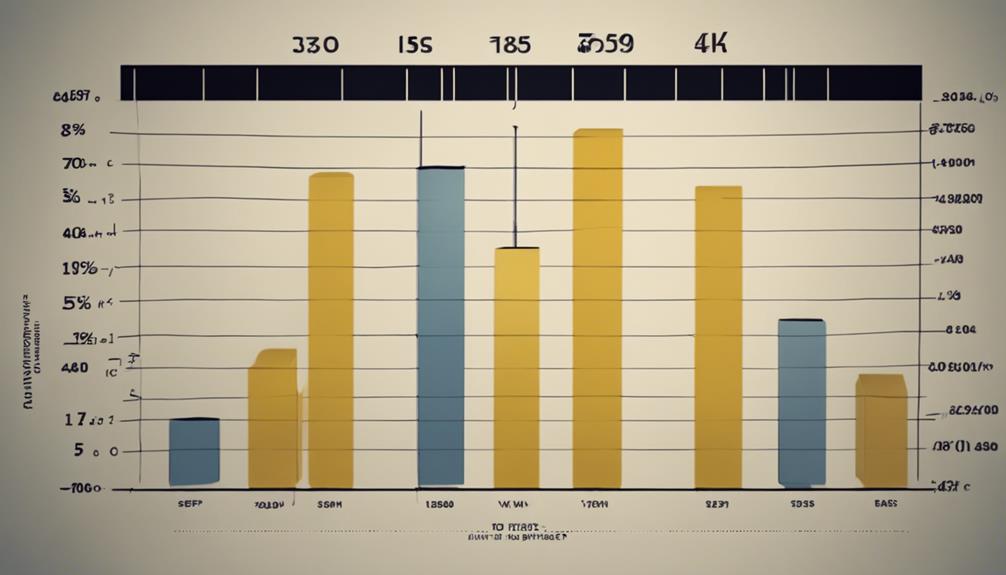To evaluate the advantages and drawbacks of each type of Gold IRA, it is important to consider differences in tax treatment, such as tax deductions for Traditional Gold IRAs and tax-free distributions for Roth Gold IRAs. Contribution limits vary but are crucial for saving for retirement. Withdrawal rules also differ, with Traditional IRAs requiring minimum distributions and Roth IRAs allowing tax-free withdrawals. SEP IRAs are a great option for self-employed individuals due to higher contribution limits. Understanding income thresholds is key to determining eligibility. Learn how these factors impact your retirement savings and tax benefits in order to create an optimal strategy. Take a deeper look into the specifics of each type of Gold IRA to make well-informed decisions.
Key Takeaways
- Traditional Gold IRAs offer tax deductions, Roth Gold IRAs provide tax-free distributions.
- Contribution limits are $6,000 annually, higher for SEP Gold IRAs.
- Age-related restrictions vary, with RMDs for Traditional Gold IRAs at age 72.
- Withdrawal rules differ; Traditional IRAs have RMDs, Roth IRAs allow tax-free withdrawals.
- Income limits affect contribution eligibility; SEP IRAs are ideal for self-employed individuals.
Tax Treatment Differences

When considering Gold IRA types, understanding the variations in tax treatment is essential for maximizing financial benefits and planning for retirement effectively. Traditional Gold IRAs offer tax deductions on contributions, allowing individuals to reduce their taxable income in the year of contribution. These contributions are made with pre-tax dollars, potentially lowering current tax liabilities.
On the other hand, Roth Gold IRAs do not provide immediate tax deductions on contributions since they are made with after-tax dollars. However, Roth Gold IRAs offer the advantage of tax-free distributions in retirement, providing a valuable source of income without additional tax burdens.
Additionally, Traditional Gold IRAs may be subject to required minimum distributions (RMDs) starting at age 72, while Roth Gold IRAs do not have RMDs during the account holder's lifetime. The difference in tax treatment between Traditional and Roth Gold IRAs has significant implications for retirement planning and tax optimization, emphasizing the importance of selecting the most suitable option based on individual financial goals and circumstances.
Contribution Limit Variances

Gold IRA contribution limits vary depending on the type of account. Traditional and Roth Gold IRAs are capped at $6,000 annually ($7,000 for those aged 50 and older). SEP Gold IRAs, designed for self-employed individuals, offer higher contribution limits as per IRS guidelines.
Understanding these variances is essential for maximizing retirement savings and managing the tax implications associated with each type of Gold IRA.
Annual Contribution Caps
Understanding the annual contribution caps for different types of Gold IRAs is important for effectively maximizing your retirement savings potential. Traditional and Roth Gold IRAs both have a contribution limit of $6,000 per year ($7,000 for those aged 50 and over).
However, SEP Gold IRAs permit higher contribution limits based on self-employment income. It's essential to recognize that contribution limits may fluctuate depending on income levels and IRS regulations.
Adhering to these caps is essential for optimizing the benefits of each Gold IRA type. By staying informed about the specific contribution limits associated with traditional, Roth, and SEP Gold IRAs, individuals can strategically plan their contributions to ensure they are taking full advantage of their retirement savings opportunities.
Age-Related Restrictions
Age-related restrictions play an important role in determining the contribution limits for different types of Gold IRAs, with specific variances based on the investor's age and retirement savings goals. When contemplating the various Gold IRA options, understanding the implications of age restrictions is vital.
Here are key points to take into account:
- Traditional Gold IRAs have set contribution limits of $6,000 ($7,000 for those aged 50 and above).
- Roth Gold IRAs have income restrictions for eligibility.
- SEP Gold IRAs offer higher contribution limits based on self-employment income levels.
- Catch-up contributions are available for individuals aged 50 and older.
These limitations and allowances influence the potential for retirement savings and tax benefits based on age and income levels.
Tax Implications Clarification
When considering different types of Gold IRAs, it is essential to grasp the nuances of tax implications, particularly in relation to contribution limit variances. Traditional Gold IRAs have set contribution limits of $6,000 ($7,000 for individuals aged 50 and above), while Roth Gold IRAs may offer different thresholds.
Solo 401(k) Gold IRAs and SEP IRAs present variations in contribution limits compared to traditional and Roth IRAs. Understanding these contribution disparities among Gold IRA types is vital for effective retirement planning and for potentially maximizing savings in precious metals.
Proper assessment of the contribution limits of various Gold IRA options is paramount in understanding the tax implications and ensuring the best growth of retirement savings.
Withdrawal Rules Contrast

Withdrawal rules for Gold IRAs vary based on the type of account. For Traditional Gold IRAs, required minimum distributions start at age 72, while Roth Gold IRAs allow tax-free withdrawals after age 59 1/2.
Understanding the IRA withdrawal age and potential penalties for early withdrawals is essential in planning for retirement and managing taxes effectively.
IRA Withdrawal Age
The disparity in withdrawal rules between Traditional and Roth Gold IRAs greatly influences retirement planning strategies and tax implications. When contemplating IRA withdrawal age, individuals need to evaluate the benefits and limitations of each type of Gold IRA. Here are some key points to take into account:
- Traditional Gold IRAs have a required minimum distribution age of 72, while Roth Gold IRAs have no age requirement for withdrawals.
- Traditional Gold IRAs mandate withdrawals starting at age 72 based on IRS guidelines, impacting retirement planning strategies.
- Roth Gold IRAs offer flexibility with no age requirement for withdrawals, allowing potential tax-free distributions in retirement.
- Understanding the impact of withdrawal age on tax obligations and retirement income is essential when choosing between Traditional and Roth Gold IRAs.
Early Withdrawal Penalties
Early withdrawal penalties differ greatly among various types of Gold IRAs, impacting the financial consequences of accessing funds before the designated age thresholds. Traditional Gold IRAs may incur a 10% penalty for withdrawals made before age 59 ½. In contrast, Roth Gold IRAs allow penalty-free withdrawals of contributions, although early withdrawal of earnings may lead to penalties. SEP Gold IRAs follow rules similar to Traditional IRAs, imposing a 10% penalty on withdrawals before age 59 ½. Withdrawals from Gold IRAs for non-qualified expenses can result in both taxes and penalties. Understanding the specific early withdrawal rules for each type of Gold IRA is essential for effective retirement planning.
| Gold IRA Type | Early Withdrawal Penalty |
|---|---|
| Traditional Gold IRAs | 10% penalty before age 59 ½ |
| Roth Gold IRAs | Penalty-free contributions; penalties on earnings |
| SEP Gold IRAs | 10% penalty before age 59 ½ |
Growth Potential Evaluation

When evaluating the growth potential of different Gold IRA types, it is essential to take into account factors such as tax implications, investment options, and contribution limits to make informed financial decisions.
Here are four key considerations for analyzing growth potential:
- Tax Deductions: Traditional Gold IRAs offer tax deductions, which can potentially enhance growth by reducing taxable income and increasing investable funds.
- Precious Metal Investments: Both Traditional and Roth Gold IRAs enable investments in precious metals, providing a unique avenue for growth potential based on market performance.
- Roth Gold IRAs: These accounts allow for tax-free distributions in retirement, amplifying growth potential by offering the opportunity for earnings to grow tax-free over time.
- Self-Employed Individuals: SEP Gold IRAs are tailored for self-employed individuals, offering higher contribution limits compared to other types, thereby maximizing growth opportunities for retirement savings.
Evaluating these factors based on individual financial goals and risk tolerance is vital in selecting the most suitable Gold IRA type to achieve long-term growth and financial stability.
Flexibility Comparison

Upon comparing the flexibility of different Gold IRA types, it becomes apparent that each option offers distinct advantages and limitations tailored to specific financial objectives.
Traditional Gold IRAs provide tax deductions, which can be beneficial for reducing taxable income. However, they come with required minimum distributions, which may limit flexibility in managing withdrawals during retirement.
On the other hand, Roth Gold IRAs offer tax-free retirement distributions, allowing for more flexibility in accessing funds without incurring additional taxes.
SEP Gold IRAs are ideal for self-employed individuals due to their higher contribution limits, providing flexibility in saving for retirement.
It is essential for investors to take into account their individual financial goals when choosing a Gold IRA type to make sure it aligns with their objectives. Understanding the benefits and limitations of each type is important in making a well-informed investment decision that suits one's financial needs and retirement plans.
Income Limit Consideration

Understanding the income limits associated with different Gold IRA types is essential for determining contribution eligibility and maximizing tax benefits based on individual financial circumstances. When considering income limits for each type of Gold IRA, there are specific factors to keep in mind:
- Traditional Gold IRA: Income limits for contributions are influenced by filing status and modified adjusted gross income.
- Roth Gold IRA: Contribution limits are subject to income limits, with phase-out ranges determined by filing status and modified adjusted gross income.
- SEP Gold IRA: While offering higher contribution limits, SEP IRAs are subject to income limits for eligibility, primarily based on self-employment income.
- Differences in Income Limits: Income limits vary across the different types of Gold IRAs, impacting contribution eligibility and potential tax advantages. Understanding these thresholds is vital for selecting the most suitable Gold IRA based on an individual's financial situation.
Frequently Asked Questions
What Are the Different Types of Gold Iras?
Gold IRAs are categorized into Traditional, Roth, Solo 401(k), and SEP IRA. Traditional Gold IRAs offer tax deductions but have mandatory distributions. Roth Gold IRAs allow tax-free retirement withdrawals. SEP Gold IRAs are tailored for self-employed individuals with higher contribution limits.
Each type has unique benefits and considerations for retirement planning. Understanding the differences among these Gold IRA types is vital for making informed decisions about retirement investment strategies.
What Is the Advantage of a Gold Ira?
A Gold IRA offers the advantage of diversifying your retirement portfolio with physical precious metals like gold, silver, platinum, and palladium.
This hedge against economic uncertainties and inflation can provide stability and preservation of wealth in the long term.
Additionally, depending on the type of IRA chosen, tax advantages such as tax-free withdrawals in Roth Gold IRAs can further enhance the benefits of holding gold in your retirement account.
What Is the Difference Between a Traditional Gold IRA and a Roth Gold Ira?
A traditional Gold IRA differs from a Roth Gold IRA primarily in how contributions are taxed. Traditional IRAs allow for tax-deductible contributions made with pre-tax dollars, while Roth IRAs are funded with after-tax dollars.
Additionally, Traditional IRAs have required minimum distributions starting at age 72, while Roth IRAs have no such requirement during the account holder's lifetime. These distinctions impact the taxation of contributions and withdrawals in retirement.
What Are the Advantages and Disadvantages of Investing in Gold?
Investing in gold offers advantages such as:
- Serving as a hedge against inflation and economic uncertainty.
- Providing a tangible asset with historical stability.
- Tax advantages through Gold IRAs.
- Portfolio diversification with the potential for consistent returns.
However, drawbacks include:
- Limited liquidity.
- Storage and insurance costs.
- Restrictions on home storage.
Evaluating personal financial goals and risk tolerance is essential in determining the suitability of gold investments.
How Do Economic Factors Impact the Benefits and Limitations of Each Type of Gold IRA?
When considering different types of Gold IRA, it’s important to understand the economic factors affecting Gold IRA. Economic conditions such as inflation, interest rates, and the stock market can impact the benefits and limitations of each type of Gold IRA. It’s crucial to consider these factors when making investment decisions.
Conclusion
To sum up, each type of Gold IRA offers unique benefits and limitations that investors should carefully consider.
While Traditional IRAs provide tax-deferred growth and potential tax deductions, Roth IRAs offer tax-free withdrawals and no required minimum distributions.
Both options have contribution limits and withdrawal rules that vary, impacting overall growth potential and flexibility.
It is important for investors to evaluate their individual financial goals and income limits before selecting the most suitable Gold IRA.
Ultimately, the hyperbolic benefits and limitations of each type highlight the need for careful consideration before making a decision.










